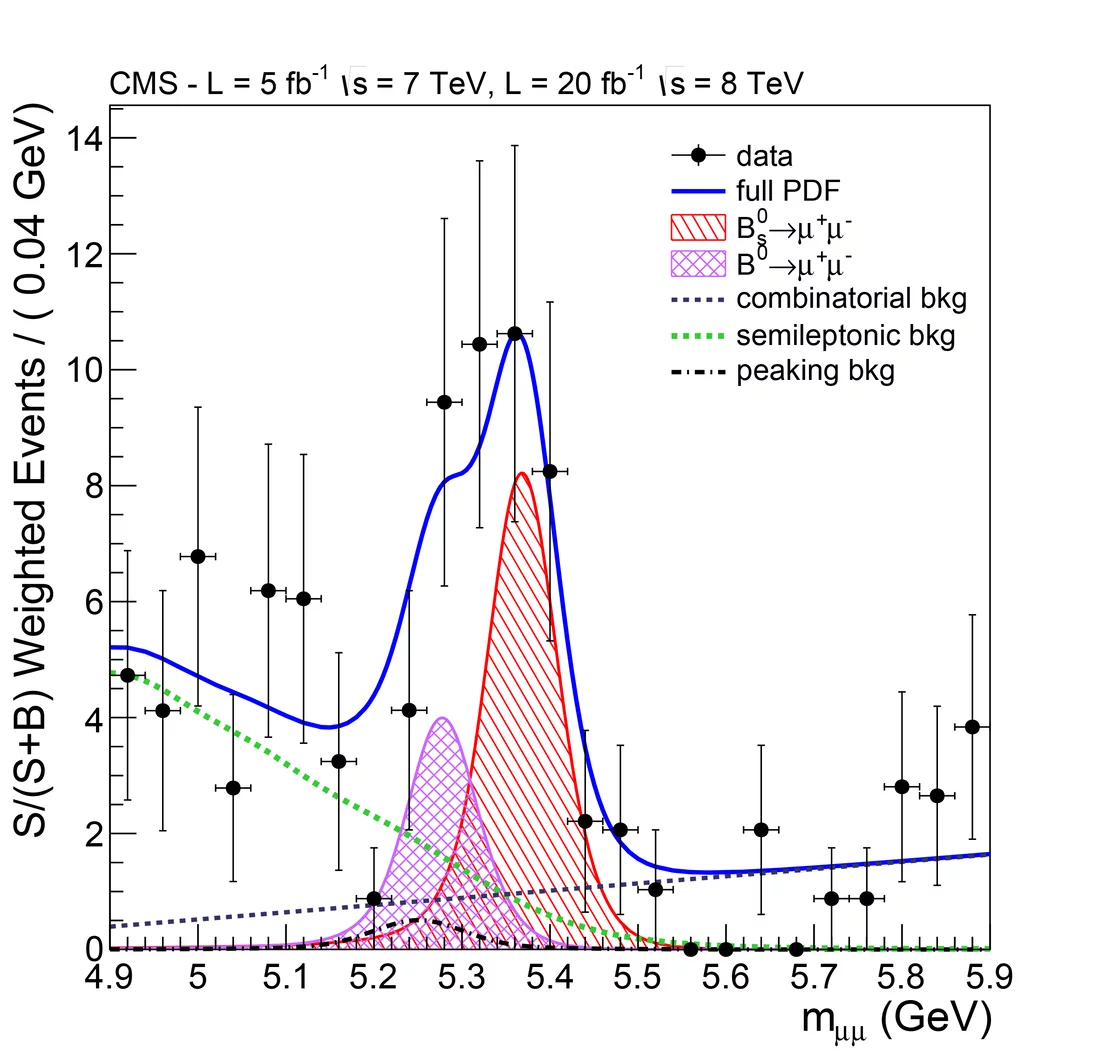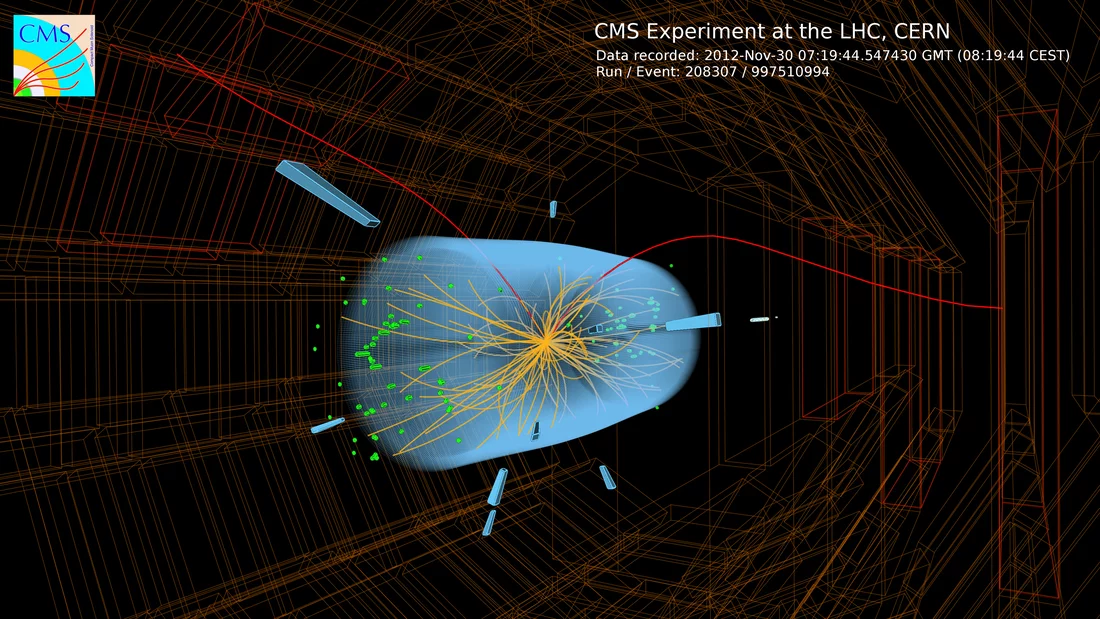Researchers from the Paul Scherrer Institute have observed for the first time the extremely rare decay of the Bs meson into two muons. They have determined its decay frequency with sufficient accuracy using data collected by the CMS detector at CERN. Their result agrees with the predictions of the standard model of particle physics.
This decay is an ideal tool to test the standard model for two reasons: First, it is possible to calculate the value predicted by the standard model accurately; secondly, the decay is so rare that even a small deviation of the measured result from the standard model predictions would be clearly detectable. Any deviation would be an indication of new physics, that is, phenomena that are not described by the standard model. Up until now, the standard model has described the behaviour of known elementary particles extremely well. However, it does not explain several observations such as the nature of the dark matter observed in the universe. Therefore, extended or revised versions of the model are required and need to be investigated.
The search for this rare decay of the Bs meson is extremely difficult as there are much more probable decay paths (only one out of 300,000,000 Bs mesons decays into this channel) The products of many of those more probable decays are very similar and have to be identified and reliably filtered out. Researchers from PSI have been working on this topic since 2005. PSI contributed the Pixel detector which is an important part of the CMS detector at CERN. The Pixel detector tracks charged particles generated from decays resulting from proton-proton collisions. Its data quality has proven to be essential for the good results coming from the CMS detector.
The standard model of particle physics describes the processes observed in the world of elementary particles extremely well. However, there are objects in the physical world that the standard model does not describe, such as the so-called dark matter
, which is observed by astronomers in space and forms a major part of the universe, and whose nature is completely unknown. Consequently, researchers are looking for modified or extended versions of the standard model that also include this additional matter. In order to decide whether the classical
standard model or a modified form describes nature correctly, researchers examine processes that can be observed, for which the various models make different predictions.
Rare decays as test of the standard model
An example of such a process is the decay of the Bs meson (see box). A Bs meson decays into other particles in a very short time (around 0.000,000,000,001,5 seconds). There are many different decay channels which result in different particles as end products, one resulting in only two muons – one positive, one negative. Two aspects make this decay particularly attractive as a test of the standard model. On the one hand, the probability the Standard Model predicts for this decay can be calculated with high precision. On the other hand, the decay is extremely improbable (according to predictions, only one in 300,000,000 Bs mesons decays in this manner), which means that even minor influences of a new physics
beyond the standard model would be evident in a considerable deviation of the decay probability from the predicted value. In the new physics
, for instance, additional particles would exist that the standard model does not describe. These could serve as an additional intermediate stage in the transformation of the Bs mesons into two muons, opening up a new path for this decay that alters its probability. Although a decay via this new channel would also be extremely improbable, its probability would be comparable to that predicted by the standard model, enabling us to detect the deviation clearly,
explains Urs Langenegger, a physicist from the high energy physics group at PSI who is heading the project. For a decay that is much more probable such a small contribution would not be detectable.
PSI researchers detect rare decays for first time
Along with other PSI researchers, Urs Langenegger has been responsible for the search for this decay within the data of the CMS detector at CERN since 2005. Their crucial task is to find the muons that stem from the decay sought for reliably among the trillions of trillions of particles that have been observed in the CMS detector in the last four years. For the first time, their analysis has now revealed that the probability of these decays is in agreement with the predictions of the standard model. The results were confirmed simultaneously by colleagues in another CERN experiment, LHCb.
Challenge: filtering out the right muons
The challenge in these studies is that a large number of the particles observed appear to be similar
to the muons sought for. These similar
particles have to be filtered out reliably. The search starts with requiring that the trajectories of a pair of muons start from a common point, which means that they can stem from the decay of one particle. Then the two muons have to have a kinetic energy that corresponds to the mass of the decayed meson. Another key criterion is isolation – in other words, there are no other particles in the vicinity of the muons that come from the same point,
explains Langenegger. Otherwise, you can end up studying two muons that come from two different decays that took place next to each other. Besides the muons, however, many other particles are created that signal to us that the muons do not come from the decay we are looking for.
In addition there are other particles in the detector that look like muons at first, which also need to be identified reliably. The multitude of criteria for distinguishing between the right
and wrong
particles had to be tested and translated into corresponding computer programmes, which could then be used to sift through the CMS data.
Nevertheless, there will always be individual muon pairs that look
as if they came from the right decay because their energies happen to correspond to the mass of the Bs meson and thus cannot be filtered out. As these pairs are produced randomly, there will be other pairs that look as if they came from the decay of a particle with another mass, producing a continuum in the mass spectrum. This means that evidence for that elusive decay has been found if a distinctly larger number of muon pairs is observed for the correct mass, above the continuum background.
Detector from PSI reveals exact particle trajectories
Researchers from the PSI were not only responsible for analysing the data for the decay of the Bs meson; they also constructed and developed a significant part of the CMS detector – the pixel detector – which constitutes the innermost component of the entire experiment. The pixel detector is able to determine the trajectories of the particles so accurately that it can be clearly distinguished if tracks emerge form the decay of the same particle or from a different one close by. All researchers analysing data from the CMS detector take advantage of information from this detector – including those searching for the Higgs particle.
Search for new physics
continues
The fact that the decay probability of the Bs meson into two muons confirms the predictions of the standard model does not mean to say that there is no new physics
. It merely rules out a series of models that indicate a different probability for this decay. There are other experiments that test predictions of the standard model, e.g. the MEG experiment, which is being performed at PSI and searches for an extremely rare decay of the muon. Next, the researchers collaborating with Urs Langenegger want to target the usual
B mesons. Its decays into two muons are also well suited to test the standard model. However, the data taken by the CERN experiments so far are insufficient to study these decays,
explains Langenegger. This will change when the large accelerator of the LHC at CERN is restarted in 2015. Perhaps the observation of the B decay will reveal physics beyond the standard model. And we’ll be right in the thick of the action again.
Background: experimenting on the LHC
In CERN’s Large Hadron Collider (Large Hadron Collider) accelerator ring, where the CMS detector is installed, bunches of protons circle in opposite directions. At four interaction points within the ring, the two beams cross so that some of the protons collide with each other head on. On average, there are twenty collisions for every bunch crossing. The proton collisions are so vigorous that a large number of new particles are formed every time. Most of them are very short-lived and decay into other particles. At each of the four collision points of the accelerator, a detector is installed. They are used to observe the particles formed and consist of several sub-detectors nested into each other like Russian dolls. The particles fly through these detectors and their properties are measured. Strong magnets in the detectors bend the electrically charged particles from their straight trajectory. From the curvature of this trajectory, their momentum can be determined, i.e. the product of mass and velocity. The information gathered enables scientists to identify which kind of the particles they are.
Background: the Bs meson and the muon
Everything around us consists of the atoms of different chemical elements, which in turn comprise neutrons and protons in their nucleus, which is orbited by electrons. Neutrons and protons consist of three quarks each – the neutron with two d and one u quark, the proton with one d and two u quarks. Besides these two kinds of quarks, the basic building blocks of our everyday lives, there are four other heavier quarks that only appear in unstable particles that decay quickly. For each of these six quarks there are anti-quarks with the same properties but with an opposite electrical charge. Composite particles either consist of three quarks or one quark and an anti-quark. The latter are referred to as mesons, including the Bs and B mesons. The Bs meson consists of one b-anti-quark and one s-quark, the B meson of one b-anti-quark and one d-quark. Much as there are heavier unstable pendants for the light quarks, there also two heavier versions of the electron – including the muon, which is around 207 times heavier and comes in two varieties – positively and negatively charged.
Text: Paul Piwnicki
About PSI
The Paul Scherrer Institute develops, builds and operates large, complex research facilities, and makes them available to the national and international research community. The Institute's own key research priorities are in the investigation of matter and material, energy and the environment; and human health. PSI is Switzerland's largest research institution, with 1500 members of staff and an annual budget of approximately 300 million CHF.
Contact
Dr Urs Langenegger, Laboratory of Particles Physics, Paul Scherrer Institute, 5232 Villigen PSI, Switzerland;Telephone: +41 56 310 47 27, Email: urs.langenegger@psi.ch
Original Publication
Measurement of the Bs0 → μ+μ- branching fraction and search for B0 → μ+μ- with the CMS experimentThe CMS Collaboration
Phys. Rev. Lett. 111, 101805 (2013)
DOI: 10.1103/PhysRevLett.111.101805
Additional information
Laboratory for Particle Physics at PSIThe quest for an elusive white crow of particle physics - popular article on the MEG experiment at PSI


